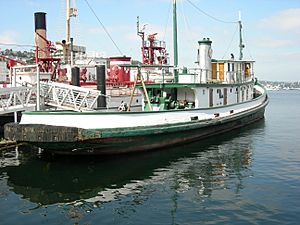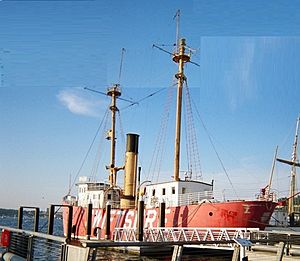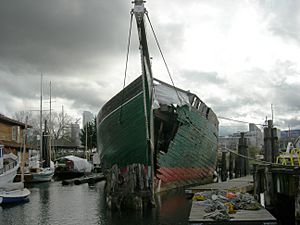Northwest Seaport facts for kids
 |
|
| Predecessor | Save Our Ships |
|---|---|
| Formation | 1964 |
| Location |
|
The Northwest Seaport Maritime Heritage Center is a special group in Seattle, Washington. It's a nonprofit, which means it works for a good cause, not for money. This organization helps keep the history of boats and the sea alive. They focus on the Puget Sound and Northwest Coast areas.
Northwest Seaport teaches people about maritime history. They do this through fun programs and experiences right on their historic ships. They own three big old ships. These ships are docked at the Historic Ships' Wharf in Seattle's Lake Union Park. The ships are the tugboat Arthur Foss (from 1889), Lightship 83 Swiftsure (from 1904), and the halibut fishing schooner Tordenskjold (from 1911). These vessels are used for many public events. These events include tours, festivals, and even workshops to learn how to fix boats.
Northwest Seaport is located next to the Center for Wooden Boats and the Museum of History and Industry. These places are all on the south side of Lake Union in downtown Seattle. They often work together on events at Lake Union Park. However, they are separate organizations. Northwest Seaport is also not connected to the Northwest Seaport Alliance. That alliance is a different group that manages the ports of Seattle and Tacoma.
Contents
History of Northwest Seaport
Northwest Seaport started in the early 1960s. It was first called the Save Our Ships project. Their first goal was to save the old Pacific schooner Wawona from 1897. Save Our Ships bought the Wawona in 1964. Then, they bought Lightship 83 "Relief" in 1966. This ship was later renamed "Swiftsure." In 1970, the Foss company gave them the tugboat Arthur Foss.
In the 1970s, Save Our Ships was based in Kirkland, on Lake Washington. Later, the group changed its name to Northwest Seaport. In the early 1980s, they moved to their current spot on Lake Union. For most of its history, Northwest Seaport has been run by volunteers.
Fun Programs and Events
Northwest Seaport offers many exciting programs. You can take public tours of the ships. They also host festivals and story times for young children. For older kids and adults, they have training in marine trades. These programs teach skills for working with boats. They also have traditional maritime music sing-alongs.
Meet the Historic Fleet
The Historic Ships Wharf at Lake Union Park has several old ships. Four of these ships are on the National Register of Historic Places. This means they are very important to American history. Two of these ships belong to Northwest Seaport. The other two belong to different groups. Northwest Seaport's third ship on the wharf is also being considered for this special historical status.
Tugboat Arthur Foss
The tugboat Arthur Foss was built in 1889. It is the oldest wooden tugboat still floating in the United States. In 1898, during the Klondike Gold Rush, it carried miners and supplies to Alaska. No other ships from that gold rush are still working today. The Arthur Foss even starred in a movie! It was in the 1933 film Tugboat Annie.
During World War II, the Arthur Foss helped with the war effort. It was the last ship to escape before the Battle of Wake Island began in December 1941. After the war, it worked in the timber industry. It retired in 1968. The Arthur Foss has a powerful 700-horsepower diesel engine. It can go up to 13 knots (about 24 kilometers per hour). The tugboat is 120 feet (36.6 meters) long. The Foss company gave the Arthur Foss to Northwest Seaport in 1970. This vessel was named a National Historic Landmark in 1989. It is also a city landmark.
Lightship 83 "Swiftsure"
Lightship #83, often called Swiftsure, is a special kind of ship called a lightvessel. It was built in Camden, New Jersey, in 1904. It served the United States Lighthouse Service from 1904 to 1939. Then, it worked for the United States Coast Guard from 1939 to 1960. Today, the ship is a museum vessel. It is docked in Seattle, Washington.
In 1904–1905, LV-83 sailed all the way around the tip of South America. Its first job was at Blunts Reef in California. There, it helped save 150 people when their ship got stuck in thick fog. In 1929, LV-83 moved to the San Francisco lightship station. During WWII, it was used as an armed patrol boat. After the war, it went back to being a lightship. In 1951, it moved to Seattle. It was then called Relief. It served as a backup ship for other lightships. These included those at the Columbia River bar, Umatilla Reef, and Swiftsure stations. The name Swiftsure comes from the Swiftsure Bank. This is a place near the entrance to the Strait of Juan de Fuca.
Swiftsure is one of the oldest lightships in the country. It is the only one that still has its original steam engine. The ship is 129 feet (39.3 meters) long. It has a beam (width) of 28 feet, six inches (8.7 meters). Its draft (how deep it sits in the water) is 12 feet, six inches (3.8 meters). It weighs 668 tons. It has a very bright light and a loud foghorn. It also has a 1,000-pound fog bell.
The ship stopped working in 1960. Northwest Seaport bought it in 1966. It is listed on the National Register of Historic Places. It was also named a National Historic Landmark in 1989. It is currently being restored on Lake Union in Seattle.
Halibut Schooner Tordenskjold
The Tordenskjold is a halibut schooner from 1911. It joined the Northwest Seaport fleet in February 2017. It was built in Seattle's Ballard neighborhood by a famous boat builder, John Strand. The Tordenskjold fished in the North Pacific and Bering Sea for over 100 years. It never missed a fishing season!
From 1911 to 1934, its crew of 14 used small boats called dories to catch halibut and cod. Later, longlines were used directly from the boat. In 1939, its second captain, Carl Serwold, changed the boat to a trawler. The Tordenskjold caught shrimp, king crab, and shark. In 1979, Marvin Gjerde and Per Odegaard bought the boat. They changed it back to a longliner. For the next 35 years, Marvin Gjerde fished for halibut and black cod. The Tordenskjold stopped active fishing at the end of the 2012 summer season. Gjerde and Odegaard gave the Tordenskjold to Northwest Seaport in 2017. The boat is kept in working condition. It visits boat shows in the area as Northwest Seaport's traveling ambassador.
Fishing Troller Twilight
Twilight is a 36-foot (11-meter) fishing vessel. It was launched from Seattle's Fishermen's Terminal in 1933. It was used for trolling (a type of fishing) in the Pacific Ocean until the 1980s. Twilight came to Northwest Seaport in 2000. It is currently stored on land. Funds are being raised to restore it.
Schooner Wawona
The Wawona was a three-masted fore-and-aft schooner. It sailed from 1897 to 1947. It carried lumber and later became a fishing vessel. It was based in Puget Sound. The schooner was built in Fairhaven, California, by H.D. Bendixsen. He was a very important West Coast shipbuilder in the late 1800s. From 1897 to 1913, it carried lumber from Grays Harbor and Puget Sound to California. One of its captains, Ralph E. "Matt" Peasley, inspired a series of popular books.
The Wawona was 165 feet (50.3 meters) long on deck. It had a 35-foot (10.7-meter) beam (width). Its masts stood 110 feet (33.5 meters) from the bottom of the ship.
The Wawona was docked at South Lake Union Park in Seattle. It was next to the Center for Wooden Boats. It was listed on the National Register of Historic Places. It was also on the Washington State Heritage Register and was a city landmark. However, the ship was decaying. Efforts to restore it did not work. So, it was taken apart in March 2009. Northwest Seaport worked with experts to save important parts of the ship. Students from East Carolina University studied the Wawona in July 2008. In March 2009, the ship was carefully taken apart. Pieces like wooden knees, beams, and paneling were saved. These pieces are now stored and will be shown in exhibits. Some parts of the Wawona were given to be used on the C.A. Thayer in San Francisco.




